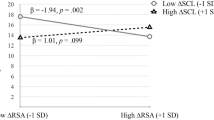Abstract
To explain blushing phobics’ fearful preoccupation with blushing, this study investigated the anticipated consequences of blushing when considering the interpersonal influences of displaying a blush. Using a vignette study approach, participants (N = 48, mean age 20.47, and SD 4.44) with variable levels of fear of blushing were instructed to imagine that they did or did not blush in several situations, and were asked to indicate their expectations of an observer’s judgment. Irrespective of their fear of blushing, participants generally attributed negative effects to their blush in these situations. This finding sustains the idea that people dislike blushing due to the anticipated influence of the blush on other’s judgments about the self, but does not support the idea that fear of blushing is fueled by an overestimation of these negative effects of blushing. Meanwhile, high-fearfuls did report a relatively high-subjective probability of displaying a blush in these situations. Expecting to blush in situations in which people generally anticipate that blushing elicits a negative observer’s judgment, may well contribute to blushing fearfuls’ preoccupation with blushing.

Similar content being viewed by others
Notes
To verify if all individual vignettes describing personal exposure were indeed successful in eliciting anticipated revealing effects of blushing in our participants, we analyzed the effects of blushing per vignette. This analysis showed that indeed all individual vignettes had revealing effects (for all individual vignettes the mean difference between blush and no blush was significant at the p < 0.001 level).
References
Bögels, S. M., Alberts, M., & de Jong, P. J. (1996). Self-consciousness, self-focused attention, blushing propensity and fear of blushing. Personality and Individual Differences, 21, 573–581.
Bögels, S. M., Mulkens, S., & de Jong, P. J. (1997). Task concentration training and fear of blushing. Journal of Clinical Psychology and Psychotherapy, 4, 251–258.
Bögels, S. M., Rijsemus, W., & de Jong, P. J. (2002). Self-focused attention and social anxiety: The effects of experimentally heightened self-awareness on fear, blushing, cognitions, and social skills. Cognitive Therapy and Research, 26, 461–472.
Bögels, S. M., & Reith, W. (1999). Validity of two questionnaires to assess social fears: The Dutch social phobia and anxiety inventory and the fear of blushing, trembling, and sweating questionnaire. Journal of Psychopathology and Behavioural Assesment, 21, 51–66.
Bögels, S. M., & Scholing, A. (1995). Behandeling van angst om te blozen, trillen of zweten. Tijdschrift voor Psychotherapie, 21, 248–267.
Castelfranchi, C., & Poggi, I. (1990). Blushing as a discourse: Was Darwin wrong? In W. R. Crozier (Ed.), Shyness and embarrassment: Perspectives from social psychology (pp. 230–251). Cambridge, UK: Cambridge University Press.
Crozier, W. R. (2000). Blushing, social anxiety and exposure. In W. R. Crozier (Ed.), Shyness: Development, consolidation and change (pp. 154–170). New York, NY, US: Routledge.
Crozier, W. R. (2001). Blushing and the exposed self: Darwin revisited. Journal for the Theory of Social Behaviour, 31, 61–72.
Crozier, W. R. (2004). Self-consciousness, exposure, and the blush. Journal for the Theory of Social Behaviour, 34, 1–17.
Darwin, C. (1989). The expression of the emotions in man and animals (pp. 163–168). New York: New York University Press (original work published in 1872).
de Jong, P. J. (1999). Communicative and remedial effects of social blushing. Journal of Nonverbal Behavior, 23, 197–218.
de Jong, P. J., & Peters, M. L. (2005). Do blushing phobics overestimate the undesirable effects of their blushing? Behaviour Research and Therapy, 43, 747–758.
de Jong, P. J., Peters, M. L., & De Cremer, D. (2003). Blushing may signify guilt: Revealing effects of blushing in ambiguous social situations. Motivation and Emotion, 27, 225–249.
de Jong, P. J., Peters, M. L., De Cremer, D., & Vranken, C. (2002). Blushing after a moral transgression in a prisoner’s dilemma game: Appeasing or revealing? European Journal of Social Psychology, 32, 627–644.
de Jong, P. J., Peters, M. L. , Dijk, C., Nieuwenhuis, E., Kempe, H., & Oelerink, J. (2006). Fear of blushing: The role of the expected influence of displaying a blush on others’ judgments. Cognitive Therapy and Research, 30, 623–634.
Dijk, C., & de Jong, P. J. (2006). Surgical treatment for blushing. The Lancet, 367, 2059.
Drott, C., Claes, G., & Olsson-Rex, L. (2002). Facial blushing treated by sympathetic denervation—longlasting benefits in 831 patients. Journal of Cosmetic Dermatology, 1, 115–119.
Drummond, P. D. (1997). The effects of adrenergic blockade on blushing and facial flushing. Psychophysiology, 34, 163–168.
Drummond, P. D. (2001). The effect of true and false feedback on blushing in women. Personality and Individual Differences, 30, 413–425.
Drummond, P. D., Camacho, L., Formentin, N., Heffernan, T. D., Williams, F., & Zekas, T. E. (2003). The impact of verbal feedback about blushing on social discomfort and facial blood flow during embarrassing tasks. Behaviour Research and Therapy, 41, 413–425.
Edelmann, R. J. (2001). Blushing. In L. E. Alden, & W. R. Crozier (Eds.), International handbook of social anxiety: Concepts, research and interventions relating to the self and shyness (pp. 301–323). New York, NY, US: Wiley.
Fahlén, T. (1997). Core symptom pattern of social phobia. Depression and Anxiety, 4, 223–232.
Foa, E. B., Franklin, M. E., Perry, K. J., & Herbert, J. D. (1996). Cognitive biases in generalized social phobia. Journal of Abnormal Psychology, 105, 433–439.
Gerlach A. L., Wilhelm F. H., Gruber K., & Roth W. T. (2001). Blushing and physiological arousability in social phobia. Journal of Abnormal Psychology, 110, 247–258.
Heinrichs, N., & Hofmann, S. G. (2001). Information processing in social phobia: A critical review. Clinical Psychology Review, 21, 751–770.
Leary, M. R. (1983). A brief version of the fear of negative evaluation scale. Personality and Social Psychology Bulletin, 9, 371–375.
Leary, M. R., Britt, T. W., Cutlip, W. D. II, & Templeton, J. L. (1992). Social blushing. Psychological Bulletin, 112, 446–460.
Leary, M. R., Landel, J. L., & Patton, K. M. (1996). The motivated expression of embarrassment following a self-presentational predicament. Journal of Personality, 64, 619–636.
Leary, M. R., & Meadows, S. (1991). Predictors, elicitors, and concomitants of social blushing. Journal of Personality and Social Psychology, 60, 254–262.
Marks, I. M., & Mathews, A. M. (1979). Brief standard self-rating for phobic patients. Behaviour Research and Therapy, 17, 263–267.
Mauss I. B., Wilhelm, F. H., & Gross, J. J. (2004). Is there less social anxiety then meets the eye? Emotion experience, expression, and bodily responding. Cognition and Emotion, 18, 631–662.
Mulkens, S., Bögels, S. M., de Jong, P. J., & Louwers, J. (2001). Fear of blushing: Effects of task concentration training versus exposure in vivo on fear and physiology. Journal of Anxiety Disorders, 15, 413–432.
Mulkens, S., de Jong, P. J., & Bögels, S. M. (1997). High blushing propensity: Fearful preoccupation or facial coloration? Personality and Individual Differences, 22, 817–824.
Mulkens, S. M., de Jong, P. J., Dobbelaar, A., & Bögels, S. M. (1999). Fear of blushing: Fearful preoccupation irrespective of facial coloration. Behaviour Research and Therapy, 37, 1119–1128.
Neto, F. (1996). Correlates of social blushing. Personality and Individual Differences, 20, 365–373.
Nicolaou, M., Paes, T., & Wakelin, S. (2006). Blushing: An embarrassing condition, but treatable. The Lancet, 367, 1297–1298.
Parkison, B., & Manstead, A. S. R. (1993). Making sense of emotions in stories and social life. Cognition and Emotion, 7, 295–323.
Pollentier, S. (1992). Wie aus der Erythropobie eine soziale Phobie wurde: Eine Ubersicht der klinisch-diagnostischen problematic. Nervenarzt, 63, 28–33.
Scholing, A., & Emmelkamp, P. M. (1993). Cognitive and behavioural treatments of fear of blushing, sweating, or trembling. Behaviour Research and Therapy, 31, 155–170.
Semin, G. R. (1982). The transparency of the sinner. European Journal of Social Psychology, 12, 173–180.
Shields, S. A., Mallory, M. E., & Simon, A. (1990). The experience and symptoms of blushing as a function of age and reported frequency of blushing. Journal of Nonverbal Behavior, 14, 171–187.
Stopa, L., & Clark, D. M. (2000). Social phobia and the interpretation of events. Behaviour Research and Therapy, 39, 273–283.
Voncken M. J., & Bögels S. M. (2006). Physiological responses, anxious appearance, and social skills in social phobia. In Afraid of being disliked. Voncken M.University Press Maastricht (Ph.D. thesis), pp. 47–77.
Voncken, M. J., Bögels, S. M., & de Vries, K. (2003). Interpretation and judgmental biases in social phobia. Behaviour Research and Therapy, 41, 1481–1488.
Acknowledgments
We are grateful to Madelon Peters, Femke Buwalda, and Marisol Vonken for their comments on an earlier version of this manuscript, to Evelien Nieuwenhuis, Henk Kempe, and Julia Oelerink for their help with conducting the study, and to Marieke Timmermans for her statistical advice and her assistance in analyzing the data. The first author was supported by a fellowship of the Netherlands Organization for Scientific Research (NWO, Grant No. 016.005.019).
Author information
Authors and Affiliations
Corresponding author
Appendix
Appendix
Possible exposure to something personal
-
City. Meeting a boy that you like but you do not want him to know this.
-
Party. At a friend’s party, the conversation suddenly turns to STDs.
-
Presentation. You are afraid to show your nervousness during a presentation to teachers.
-
Colleague. A colleague tells you she knows that you have complained about her; you try to deny this.
Negative Judgment by Others
-
Happy Birthday. During class you have to stand on a chair and the whole class of students sings “Happy Birthday” to you.
-
Wedding. You are Master of Ceremonies at your best friend’s wedding and you have to give a speech.
-
Clothes. You get a compliment from a friend about your clothes. Then everybody focuses their attention on you and confirms that you look good.
-
Daydreaming. You are daydreaming during a formal lecture. Suddenly the teacher asks you something.
Rights and permissions
About this article
Cite this article
Dijk, C., de Jong, P.J. Fear of Blushing: No Overestimation of Negative Anticipated Interpersonal Effects, But a High-Subjective Probability of Blushing. Cogn Ther Res 33, 59–74 (2009). https://doi.org/10.1007/s10608-007-9145-y
Received:
Accepted:
Published:
Issue Date:
DOI: https://doi.org/10.1007/s10608-007-9145-y




